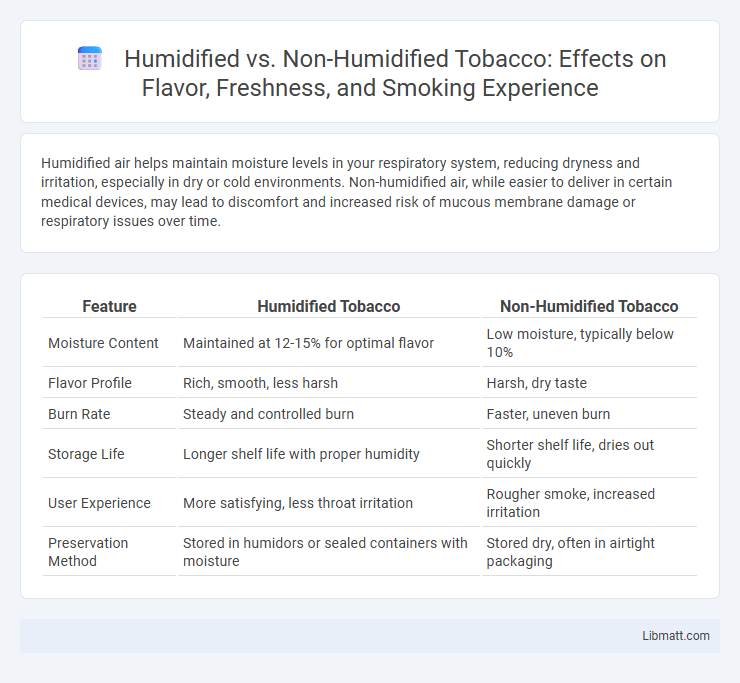Humidified air helps maintain moisture levels in your respiratory system, reducing dryness and irritation, especially in dry or cold environments. Non-humidified air, while easier to deliver in certain medical devices, may lead to discomfort and increased risk of mucous membrane damage or respiratory issues over time.
Table of Comparison
| Feature | Humidified Tobacco | Non-Humidified Tobacco |
|---|---|---|
| Moisture Content | Maintained at 12-15% for optimal flavor | Low moisture, typically below 10% |
| Flavor Profile | Rich, smooth, less harsh | Harsh, dry taste |
| Burn Rate | Steady and controlled burn | Faster, uneven burn |
| Storage Life | Longer shelf life with proper humidity | Shorter shelf life, dries out quickly |
| User Experience | More satisfying, less throat irritation | Rougher smoke, increased irritation |
| Preservation Method | Stored in humidors or sealed containers with moisture | Stored dry, often in airtight packaging |
Introduction to Humidified vs Non-humidified Systems
Humidified systems add moisture to the air, improving comfort and preventing dryness in respiratory pathways, while non-humidified systems deliver air without additional moisture, which may lead to irritation during prolonged use. Choosing between humidified and non-humidified systems depends on factors like the environment, medical requirements, and your sensitivity to dry air. Understanding the benefits and limitations of each system helps optimize air quality and respiratory health in various settings.
Understanding Humidification: Definitions and Concepts
Humidified oxygen therapy delivers air enriched with moisture to prevent dryness in the respiratory tract, enhancing patient comfort and mucociliary function during breathing support. Non-humidified oxygen lacks added moisture, which can lead to airway irritation, dryness, and impaired mucous clearance over time. Understanding the role of humidification is essential for optimizing respiratory care, particularly in patients requiring prolonged oxygen therapy or mechanical ventilation.
Key Differences Between Humidified and Non-humidified Environments
Humidified environments maintain optimal moisture levels to prevent dryness and improve air quality, while non-humidified environments lack this controlled moisture, often resulting in dry air that can lead to irritation and discomfort. Key differences include their impact on respiratory health, skin hydration, and the preservation of wooden furniture or musical instruments. Your choice between humidified and non-humidified spaces directly affects comfort, energy efficiency, and the longevity of household items.
Applications in Healthcare: When Is Humidification Essential?
Humidified oxygen therapy is essential in healthcare settings for patients with artificial airways, such as endotracheal tubes or tracheostomies, to prevent mucosal drying and maintain airway patency. Non-humidified oxygen may be suitable for short-term use in patients with intact upper airways and minimal secretion production, reducing the risk of airway irritation. Proper humidification improves mucociliary function, reduces the risk of infection, and enhances patient comfort during prolonged respiratory support.
Respiratory Health: Impact of Humidified vs Non-humidified Air
Humidified air helps maintain optimal moisture levels in the respiratory tract, reducing irritation and improving mucus clearance, which is crucial for preventing respiratory infections and conditions like asthma and bronchitis. Non-humidified air often leads to dryness in the nasal passages and throat, increasing susceptibility to inflammation, congestion, and respiratory discomfort. Proper humidification supports ciliary function and enhances overall respiratory health by promoting better airway hydration and defense mechanisms.
Equipment and Technology: Devices for Humidification
Humidified oxygen therapy uses advanced equipment such as heated humidifiers and ultrasonic nebulizers to add moisture to the oxygen, preventing dryness and enhancing patient comfort during respiratory support. Non-humidified oxygen delivery typically relies on simpler devices like nasal cannulas or oxygen masks without integrated moisture control, which can lead to mucosal irritation over prolonged use. Modern humidification technology features sensors and temperature controls that optimize humidity levels, ensuring effective hydration and reducing airway complications.
Benefits of Humidified Systems
Humidified systems enhance respiratory comfort by maintaining optimal moisture levels in inhaled air, reducing dryness and irritation in the airways. They help prevent complications such as mucosal damage, thickened secretions, and infection in patients requiring respiratory support. Maintaining airway humidity also improves mucociliary clearance, promoting better lung function and reducing the risk of ventilator-associated pneumonia.
Potential Risks and Drawbacks of Non-humidified Air
Non-humidified air can lead to dry respiratory passages, increasing the risk of irritation, nosebleeds, and susceptibility to infections. It may cause discomfort such as dry skin, chapped lips, and exacerbation of respiratory conditions like asthma or bronchitis. You may experience reduced comfort and compromised mucosal defense, making proper humidity levels crucial for respiratory health.
Factors to Consider When Choosing Humidification
Choosing between humidified and non-humidified respiratory systems depends on factors such as patient comfort, airway dryness, and infection risk. Humidified air reduces mucosal irritation and promotes secretion clearance, benefiting those with sensitive airways or prolonged ventilation. Your clinical setting, device compatibility, and the patient's condition must guide the decision to optimize respiratory care outcomes.
Conclusion: Selecting the Right System for Optimal Outcomes
Choosing between humidified and non-humidified systems depends on patient needs, clinical settings, and device compatibility. Humidified systems enhance airway comfort and reduce mucosal damage, promoting better respiratory outcomes, while non-humidified systems may be suitable for short-term or less critical use. Your healthcare provider can help determine the optimal approach to balance effectiveness and patient comfort for the best results.
Humidified vs Non-humidified Infographic

 libmatt.com
libmatt.com